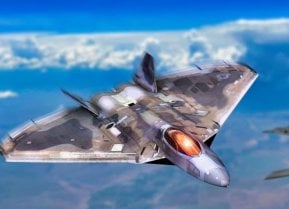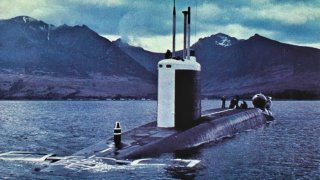Resolution-Class SSBN: How the Royal Navy Could Have Nuked Russia
The lead-boat Resolution (S22) was completed in October 1967 and began her first patrol the following year. The submarines remained in service until they were replaced by the Trident-armed Vanguards beginning in 1995.
Introducing the Resolution-Class: In February 1963, the British government announced that it would build four or five nuclear-powered ballistic missile submarines (SSBNs), which would be armed with the American Polaris SLBM, to take over the British nuclear deterrent role from the Royal Air Force by 1968. The eventual class included the lead-boat Resolution (S22), along with the Repulse (S23), Renown (S26) and Revenge (S27).
The subs were built by Vickers Armstrong in Barrow-in-Furness and Cammel Laird in Birkenhead between 1964 and 1968 – and all four of the nuclear-powered submarines were based at HM Naval Base Clyde (HMS Neptune), 25 miles west of Glasgow, Scotland. The nuclear-powered subs were the launch platform for the UK's strategic nuclear deterrent from the late 1960s until 1996, when they were replaced by the Vanguard-class submarines carrying the Trident II missile.
U.S. Influence
The design, construction, and deployment of the Resolution-class was claimed to have been the only British defense procurement program to have been completed under budget. Part of that may be owed to the fact that the overall hull appearance of the new nuclear-powered submarines was reminiscent of the earlier Valiant-class boats, while some features were borrowed from the American Lafayette-class subs. This included the compartment to house the American-originated missiles, with the missile section inserted between the bow and sterns sections during final assembly.
The hull was assembled on the berth from sections that were prefabricated in the assembly shop. The fore and aft parts were built up simultaneously, with the prefabricated missile sections –complete with missile tubes – being fitted into the spaces between.
More than 10,000 carefully detailed drawings were prepared, while a full-scale wooden "mock-up" of the lead boat was also built. That allowed positioning of every piece of equipment, but also for the placement of and routes of cables, pipes and trucking to be decided upon. In addition, it enabled the crew to undergo training and to become familiar with the submarine before they even set foot on her.
Key Facts
The Resolution-class boats had launch tubes for each of the 16 Polaris A3 SLBMs. Although designed for strategic missile attack, the Resolution-class submarines were still fitted with six 533mm (21-inch) torpedo tubes in the forward part of the hull.
The submarine's powerplant was a pressurized water-cooled reactor that powered two steam turbines, driving the single shaft which provided a top speed of 25 knots underwater. The range was unlimited.
The normal crew on the submarines was 154, and each "Ship Submersible Ballistic Nuclear" (SSBN) had two crews – known as "port" and "starboard" – alternating on each voyage of approximately three months' duration. When based ashore, the crews took leave and did refresher training with the 10th Submarine Squadron, based at Faslane on the River Clyde, Scotland. Extended leave was necessary as the crew members spent months underwater in the confined spaces – and end it was found that it took days for their eyes to adjust to long distance again.
The lead-boat Resolution (S22) was completed in October 1967 and began her first patrol the following year. The submarines remained in service until they were replaced by the Trident-armed Vanguards beginning in 1995.
About the Author
Peter Suciu is a Michigan-based writer who has contributed to more than four dozen magazines, newspapers and websites. He regularly writes about military hardware, and is the author of several books on military headgear including A Gallery of Military Headdress, which is available on Amazon.com. Peter is also a Contributing Writer for Forbes.


